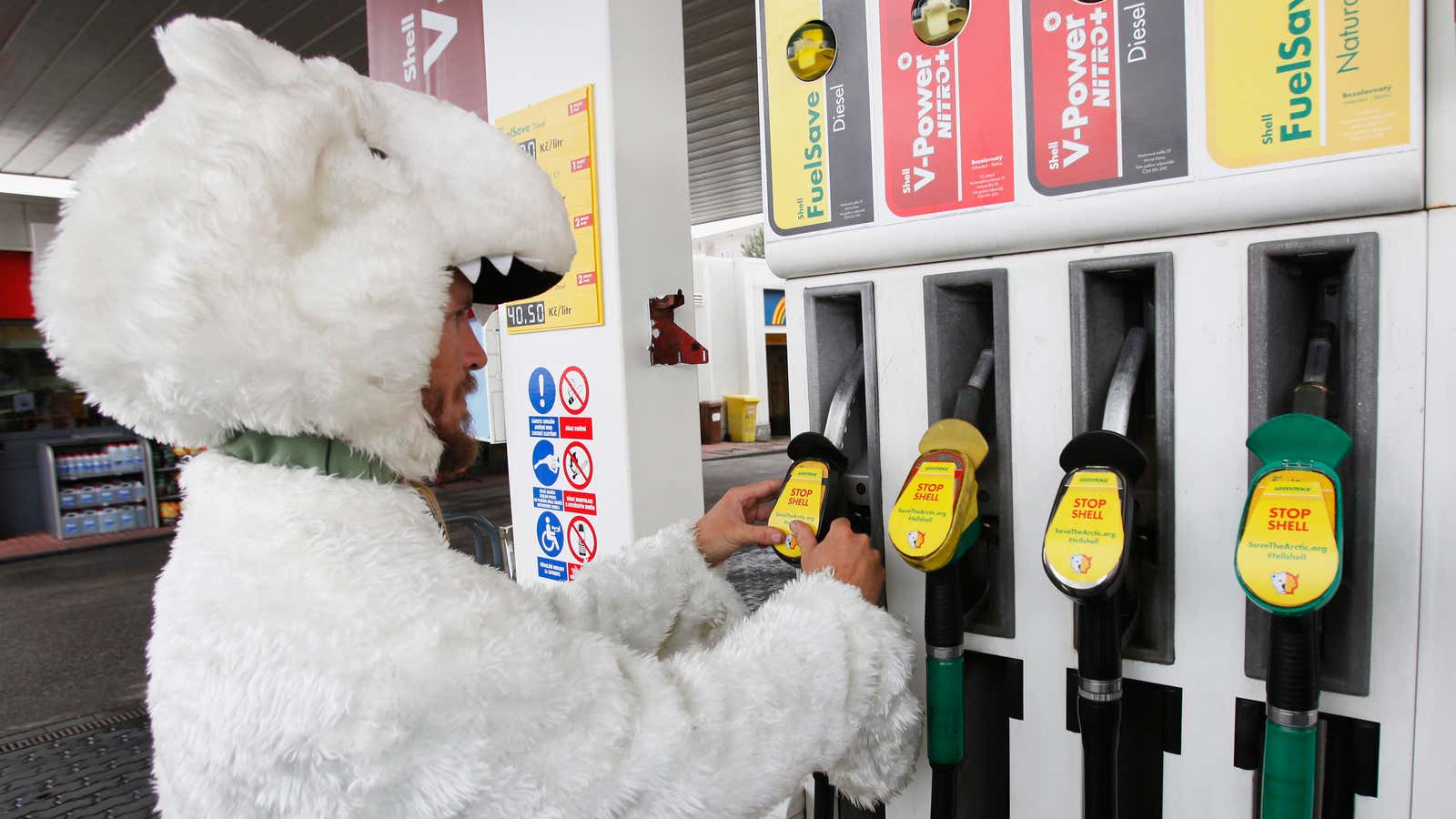Shell wants to make fossil fuels more palatable for the environmentally-conscious consumer.
Starting Apr. 17, across the Netherlands (and later in other countries), the oil giant will give customers at the gas pump the option to add €0.01 per liter of fuel, which the company will then use to “offset” the carbon emissions of that gasoline. The money will go towards buying carbon credits from “nature-based” projects, according to a Shell press release.
It isn’t the first oil company to try this sort of scheme. BP has been running “Target Neutral,” a platform for anyone to buy carbon credits, for some years. BP claims to have offset some 3 million metric tons of carbon dioxide. For context, global annual carbon emissions are approximately 40 billion metric tons. Last month, Italian oil company Eni announced a reforestation plan to offset some of its emissions.
Shell claims its plan is bigger and bolder. It’s investing $300 million over three years. Simple calculations show that’s likely to offset 60 million metric tons of carbon emissions. More importantly, it claims paying a tiny bit extra for fuel will allow motorists to drive “carbon neutral.”
These sorts of carbon offsets can work in theory, but in practice, their viability depends on the specifics of the project. (And it’s worth noting that offsets only counter carbon emissions. Gas-powered cars still spew harmful particulate-matter pollution into the air we breathe.)
A newly planted tree, for example, can take as many as 20 years to capture the amount of CO2 that a carbon-offset scheme promises. On the other hand, direct air capture removes CO2 directly from the air and buries it underground, providing almost instantaneous carbon offsets.
Those two types of offsets (among many other types), however, come at wildly different costs. Planting trees and letting them grow to capture carbon dioxide can cost as little as $5 per metric ton of carbon dioxide captured. Direct air capture technology is projected to run as high as $250 per metric ton.
The best way to think about Shell’s program is to see it as a voluntary carbon price of €0.01 per liter of gasoline. And if you look closely at the numbers, they don’t add up.
When a car burns a liter of gasoline, it emits approximately 2 kg of carbon dioxide. That means to offset one metric ton of CO2, you’ll need to pay an additional €5 ($5.6) for every 500 liters of fuel you use. That’s far too little. The most conservative estimate for the likely future economic damage of CO2 emissions is $31 per metric ton.
Maarten Wetselaar, Shell’s director of gas and new energy, admits that the carbon-offset market is immature. “We believe that for this market to really scale up, bigger players need to get involved,” he told the Financial Times (paywall).
Since oil companies stopped denying climate change and accepted the facts, they’ve all publicly supported carbon pricing. (In practice, however, many still fund lobbying groups that oppose carbon pricing.) In the past year, Shell has committed to reducing its emissions, including those from the fossil fuels it sells, by 3% by 2021. It aims to cut its total emissions by 50% by 2050. It has even tied executive pay to meeting these emission-reduction targets.
And, like other companies in its sector, Shell has faced shareholder activism forcing it to align with the goals of the Paris climate agreement (or at least pay lip service to those efforts).
But, in effect, Shell’s offset price—borne by its customers—is nowhere close to accounting for the likely damage caused by the use of its fossil fuels. That’s why some see Shell’s offset plan as little more than PR. “Shell’s move provides a great narrative,” says Charlie Kronick, a senior advisor at Greenpeace UK. “But 95% of Shell’s capital expenditure is still connected to fossil-fuel extraction.”
Carbon offsets should be used only as a last resort, says Gilles Dufranse, policy officer with Carbon Market Watch, a non-profit advocacy group. The first step should be to reduce emissions. On that front, most oil companies are far behind the goals set under the Paris climate agreement.
That said, Kronick concedes, “the policy is a welcome change nonetheless.“
“To be fair, Shell is the front runner among other oil companies,” he adds. The Dutch activist investor Follow This, which led many of the campaigns on Shell’s climate targets in the past, says that Shell has become an industry leader on setting emissions targets and it will be focusing on other oil companies instead. That’s why, this year, Follow This withdrew a resolution that would have forced the company to set even tougher climate goals.
